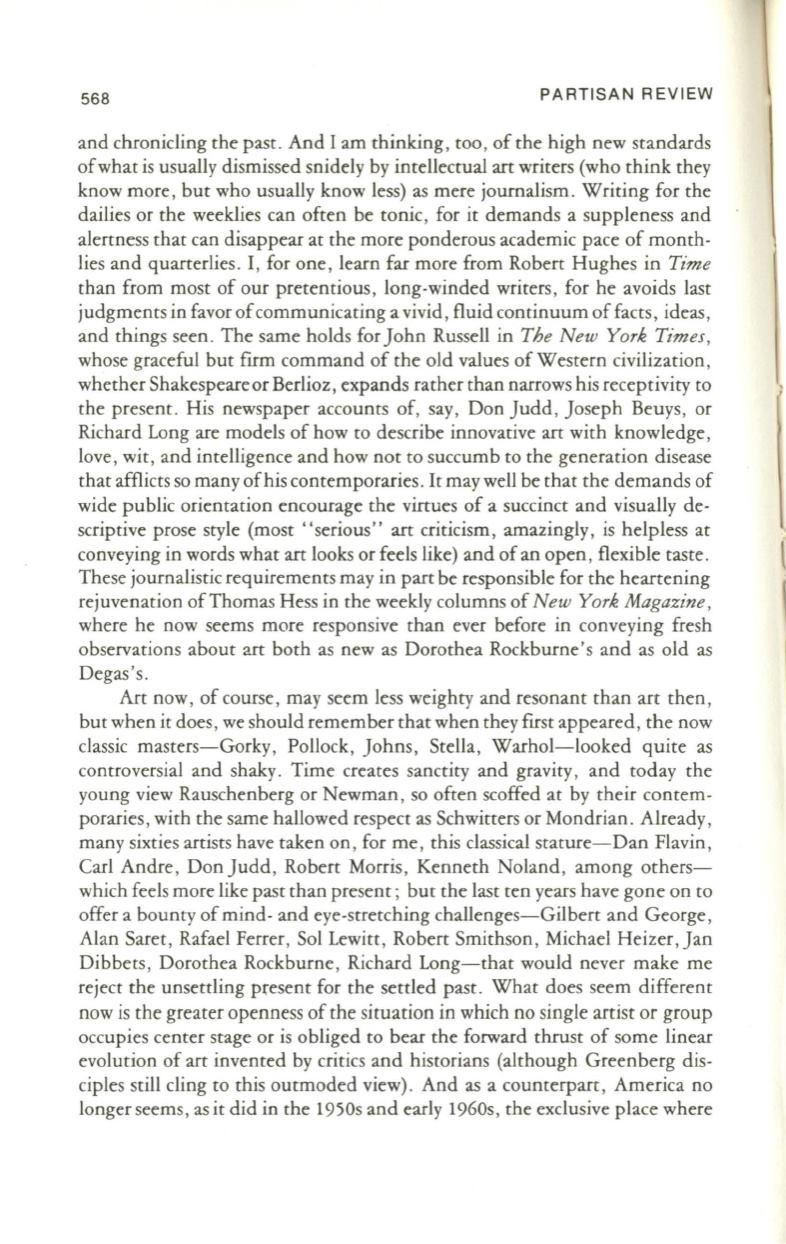
568
PARTISAN REVIEW
and chronicling the past. And I am thinking , too , of the high new standards
ofwhat is usually dismissed snidely by intellectual
art
writers (who think they
know more, but who usually know less) as mere journalism. Writing for the
dailies or the weeklies can often be tonic, for it demands a suppleness and
alertness that can disappear at the more ponderous academic pace of month–
lies and quarterlies. I, for one, learn far more from Robert Hughes in
Time
than from most of our pretentious, long-winded writers , for he avoids last
judgments in favor ofcommunicating a vivid, fluid continuum of facts , ideas ,
and things seen. The same holds for John Russell in
The New York Times,
whose graceful but firm command of the old values of Western civilization ,
whether Shakespeareor Berlioz, expands rather than narrows his receptivity to
the present . His newspaper accounts of, say, Don Judd , Joseph Beuys, or
Richard Long are models of how to describe innovative art with knowledge ,
love , wit, and intelligence and how not to succumb to the generation disease
that afflicts so many of his contemporaries .
It
may well be that the demands of
wide public orientation encourage the virtues of a succinct and visually de–
scriptive prose style (most "serious"
art
criticism, amazingly, is helpless at
conveying in words what
art
looks or feels like) and of an open, flexible taste.
These journalistic requirements may in part be responsible for the heartening
rejuvenation of Thomas Hess in the weekly columns of
New York Magazine ,
where he now seems more responsive than ever before in conveying fresh
observations about art both as new as Dorothea Rockburne's and as old as
Degas's .
Art now, of course , may seem less weighty and resonant than art then ,
but when it does , we should remember that when they first appeared , the now
classic masters-Gorky, Pollock, Johns, Stella, Warhol-looked quite as
controversial and shaky. Time creates sanctity and gravity, and today the
young view Rauschenberg or Newman , so often scoffed at by their contem–
poraries, with the same hallowed respect as Schwitters or Mondrian . Already ,
many sixties artists have taken on, for me, this classical stature-Dan Flavin,
Carl Andre , Don Judd , Robert Morris , Kenneth Noland, among others–
which feels more like past than present ; but the last ten years have gone on to
offer a bounty of mind- and eye-stretching challenges-Gilbert and George,
Alan Saret, Rafael Ferrer, Sol Lewitt, Robert Smithson, Michael Heizer, Jan
Dibbets , Dorothea Rockburne , Richard Long-that would never make me
reject the unsettling p(esent for the settled past. What does seem different
now is the greater openness of the situation in which no single artist or group
occupies center stage or is obliged to bear the forward thrust of some linear
evolution of
art
invented by critics and historians (although Greenberg dis–
ciples still cling to this outmoded view) . And as a counterpart , America no
longer seems, as it did in the 1950s and early 1960s, the exclusive place where


